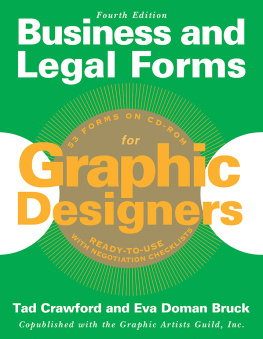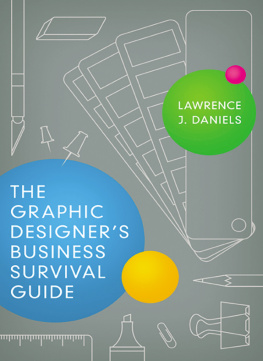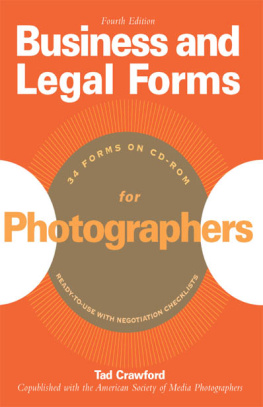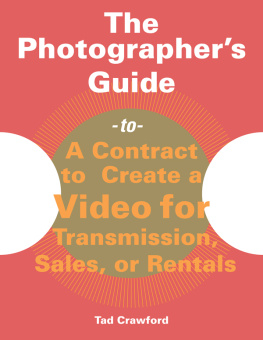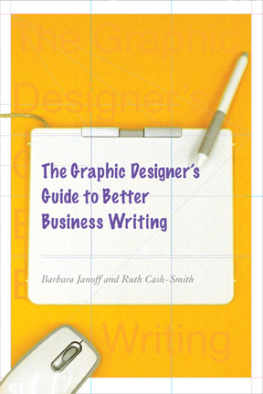Business and
Legal Forms
for
Graphic
Designers
Fourth Edition
Business and
Legal Forms
for
Graphic
Designers
Tad Crawford and Eva Doman Bruck
Fourth Edition

Copyright 1990, 1996, 1999, 2003, 2013 by Tad Crawford Copyright
1990, 1996, 1999, 2003, 2013 by Stuart Bruck
All Rights Reserved. Copyright under Berne Copyright Convention, Universal Copyright Convention, and Pan American Copyright Convention. No part of this book may be reproduced, stored in a retrieval system, or transmitted in any form, or by any means, electronic, mechanical, photocopying, recording or otherwise, without the express written consent of the publisher, except in the case of brief excerpts in critical reviews or articles. All inquiries should be addressed to Allworth Press, 307 West 36th Street, 11th Floor, New York, NY 10018.
Allworth Press books may be purchased in bulk at special discounts for sales promotion, corporate gifts, fund-raising, or educational purposes. Special editions can also be created to specifications. For details, contact the Special Sales Department, Allworth Press, 307 West 36th Street, 11th Floor, New York, NY 10018 or info@skyhorsepublishing.com.
17 16 15 14 13 5 4 3 2 1
Published by Allworth Press, an imprint of Skyhorse Publishing, Inc.307 West 36th Street, 11th Floor, New York, NY 10018. Allworth Press is a registered trademark of Skyhorse Publishing, Inc., a Delaware corporation. www.allworth.com
Cover design by Derek Bacchus
Interior page design by Douglas Design Associates, New York
Page composition/typography by Susan Ramundo
Library of Congress Cataloging-in-Publication Data is available on file.
ISBN: 978-1-62153-249-1
Printed in China
This book is designed to provide accurate and authoritative information with respect to the subject matter covered. It is sold with the understanding that the publisher is not engaged in rendering legal, accounting, or other professional services. If legal advice or other expert assistance is required, the services of a competent attorney or professional person should be sought. While every attempt is made to provide accurate information, the authors or publisher cannot be held accountable for any errors or omissions.
A System for Success
T he knowledge and use of good business practices are essential for the success of any professional or company, including the graphic designer and the design firm. The forms contained in this book deal with the most important business transactions that a designer or design firm is likely to undertake. At the back of the book is a CD-ROM that will allow the designer to customize and easily revise the forms. The fact that they are designed for use, and favor the designer if negotiations are necessary, give them a unique value.
The purpose of Business and Legal Forms for Graphic Designers is, in part, to provide information, systems, and forms that are useful to the organization and smooth functioning of the business side of the graphic design studio. It is possible to adopt (or adapt) the entire system or alter its parts to fit the particular needs of the individual studio. Each of these organizational forms can stand on its own or be used as a component of an integrated system. While an orderly system is essential to accurate record-keeping, flexibility is important to make the system responsive to changing circumstances.
Doing Business
The organization of the forms is based upon the typical chronology of events which occur in the course of doing business in the graphic design profession (with forms for the more sophisticated contracts coming last). As a starting point, the book begins with a very detailed estimate form for clients, which is used to assess the time and costs that a proposed job may require. This form can serve as an internal estimating form. It may also be a document that is shared with the client or it may be used internally or externally as a means of tracking the budget and time spent for ongoing projects in summary format.
Throughout the forms, by the way, there is a selective use of the words job and project because, while both words refer to the same activity, forms which the clients will never see use the word job and communications that the client will receive use the word project. The slightly more formal tone that is used to communicate with clients need not appear on everyday internal forms.
Once the project has been estimated internally and fees determined, the designer is then able to draft a proposal, which the client may sign to make a binding contract. Or the project confirmation form, which is more formal, may be used once the client has approved the contract.
The credit reference form is used to ensure that an unknown client has a satisfactory history of bill paying. After this is confirmed and the client signs to commit to the project, the assignment may be considered a job. Several steps are taken to open the system for tracking a job on its course through the studio. The job is first assigned a number via the jobs index, then a job sheet is opened to begin the process of recording time and costs expended on the assignment. Time sheets will show staff time expended. The studio production schedule is used to deliver the job on time.
During the course of the assignment, the project status report is used to keep the client informed of the ongoing work, and the work change order form confirms changes ordered by the client. In order to gather competitive bids for components of the job that are produced outside of the studio, the estimate request form is distributed to prospective vendors. The purchase order form serves as the designers confirmation to a vendor to supply materials or services. It may be used to contract for illustration and photographic services, but needs to be modified for such uses. Large studios use internal requisition forms as a way of efficiently managing the purchase and allocation of needed supplies.
The payables index provides a way of tracking all incoming bills as well as a system for having these bills reviewed and identified as billable or not billable. The multi-use transmittal form has been designed for maximum flexibility and ease of use. The artwork log keeps track of all materials leaving the studio and their location within the studio once they have been returned.
Billing is an extremely important task, whether done during the course of the assignment or at its completion. The billing index provides the studio with invoice numbers as well as a handy guide for reviewing the status of payments due. Two invoice forms are provided, one in a generalized outline form and the other with a more detailed and comprehensive format. Monthly billing statements and collection letters are provided in a form that can be used directly.
Contracts
The forms then shift to focus more on the contractual relationships of the firm with clients and others in the outside world. Contracts with illustrators or photographers, printers, agents, lecture sponsors, and manufacturers of licensed designs are provided along with checklists for negotiating deals. Release forms are given for the use of images of models and property. A permission form to use copyrighted materials, a copyright transfer form, a copyright registration form (Form VA), a trademark application, employment forms, and lease forms are also included.
A contract is an agreement which creates legally enforceable obligations between two or more parties. In making a contract, each party gives something of value to the other party. This is called the exchange of consideration. Consideration can take many forms, including the giving of money or an artwork or the promise to create an artwork or pay for an artwork in the future.
Next page
